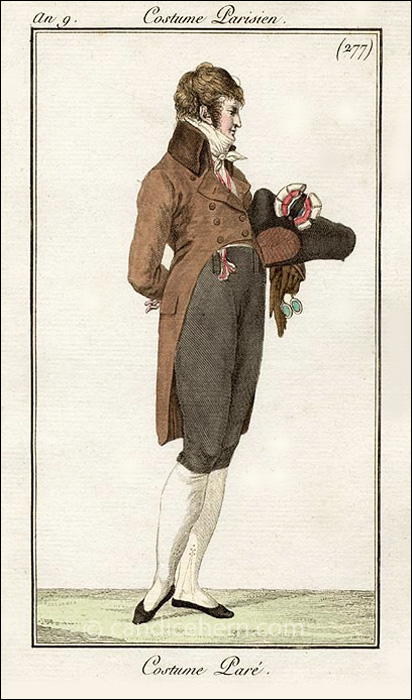Journal des Dames et des Modes, Paris, February 4, 1801.
“Costume Paré”
 French prints of ladies that are titled Grand Paré represent full dress. Perhaps Costume Paré represents full dress for a gentleman, as this is clearly evening wear. Perhaps not as formal as court dress, but appropriate for a formal evening event. Or it could be something a gentleman would wear for the opera or theater, as suggested by the opera glasses, or lorgnette, in the gentleman’s left hand. If that is the case, this might best be described as evening half dress.
French prints of ladies that are titled Grand Paré represent full dress. Perhaps Costume Paré represents full dress for a gentleman, as this is clearly evening wear. Perhaps not as formal as court dress, but appropriate for a formal evening event. Or it could be something a gentleman would wear for the opera or theater, as suggested by the opera glasses, or lorgnette, in the gentleman’s left hand. If that is the case, this might best be described as evening half dress.
The coat is cut high in the waist, as was typical of this period, although this example is a bit exaggerated in the manner of the Incroyables. Generally, especially in England, one would see more of the waistcoat below the edge of the coat. But here, the white waistcoat is unusually short, with very little showing below the coat. The black knee breeches are extremely high-waisted, again in the manner of the Incroyables, cut high enough to be completely covered by the short waistcoat and coat. The high-standing collar of the coat and the neckcloth tied high at the throat is typical of the period, and not exaggerated.
Besides the lorgnette, the gentleman is holding his right-hand glove in his left hand, and a tricorn hat tucked under his left arm. Full dress generally called for a chapeau bras, that is, a formal hat carried under the arm but not worn. However, most chapeaux bras were bicorn hats, which were much more easily tucked underneath an arm. This tricorn hat looks like it was meant to be worn, especially as it is adorned with a cockade.
He also appears to have a red ribbon tied around his neck that hangs below the waist of the coat with something that looks like a fob. But fobs were not typically worn from ribbons. Quizzing glasses were, however. It is not clear what the object is, but it might well be a quizzing glass.
Note also the simple but elegant clocks on his white stockings.







